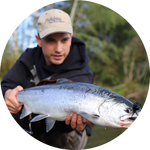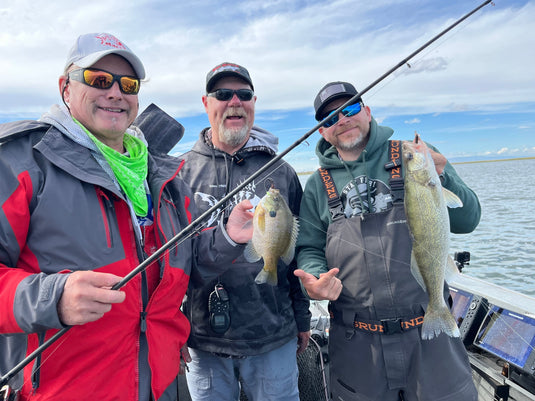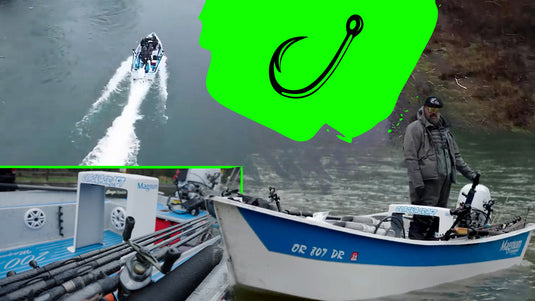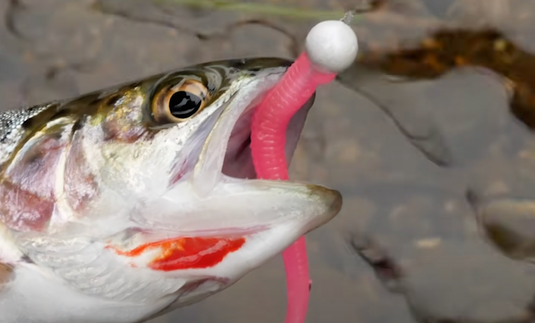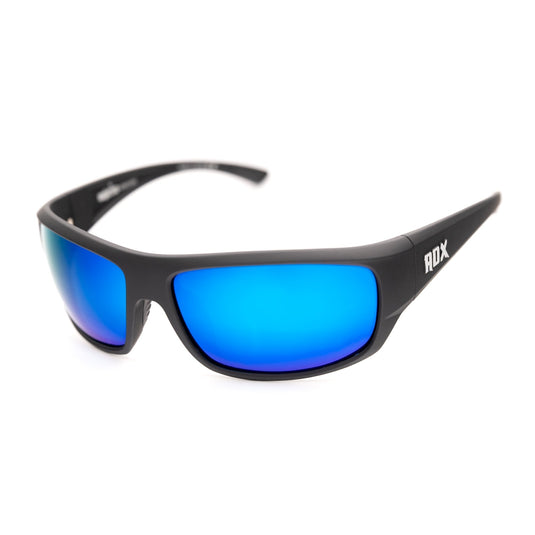Warmwater Baits for Big Bass
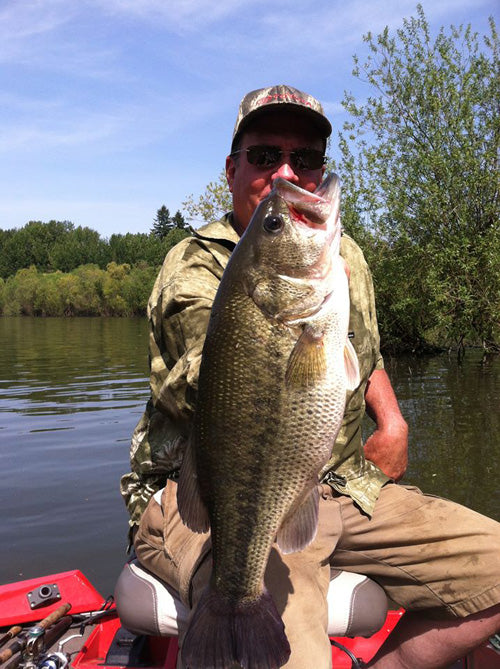
There will be a remaining week of cooler-than-average weather for May 2013, then temperatures will ramp up for Summer. Our lakes, rivers and river backwaters will warm up as well. There will still be some Bass spawning for weeks to come, but overall the fish will be moving into post-spawn and active feeding behaviors – except during very hot weather, times of low oxygen and unfavorable barometric pressures – that will culminate in the Fall Feeding Frenzy, as waters begin to chill and daylight hours shorten again.
 Bob the Bassmaster!
Bob the Bassmaster!
Most big Largemouth Bass in our area are going to be caught in 1 to 6 feet of water. You may find some deeper, but on average you are looking for shallow fish. Even so you should take into account the entire water column when choosing your Bass ammunition.
We’ll start with surface baits. ‘Frogs’ should top the list since unlike buzzbaits, they can be ‘parked’ and then twitched in one place, alerting fish to their presence, then tantalizing them with noise and vibrations. A very effective tactic is to ‘moonwalk’ the frog. ‘Wag’ and ‘walk’ the frog, yet keep it as close to one place as possible. Some frogs are easier to do this with. Experiment with River 2 Sea and others to find the one that will stay in one place for you. Walking the frog through ambush points is great, and do not neglect a trip across open water. It may not seem ‘froglike’ to you, but the fish are watching! Remember to wait for your rod to ‘load up’ when the fish humps the water and splashes, then set the hook. Steelhead reflexes are the wrong medicine here. You can actually snatch the bait away from the fish if you try to nail him too soon. This applies to other surface baits as well. Have different models of buzzbaits available. A more subtle, in-line buzz might be great one day – or night! – while a noisy ‘clacking,’ multiblade outfit might be what the fish want at another time. I believe that grub trailers in contrasting colors, or black, add to the attractiveness of your buzzbait. Chuggers and poppers can work well too. They can be made to produce different, louder or softer, noises as well, simply by your technique. It feels like real, classic Bass fishing to me, when I whack a topwater fish on an old, Fred Arbogast chugger! Do not neglect floating soft plastics among your topwater offerings. A slow-moving lizard, or a worm hooked ‘wacky’ in the middle can draw in curious fish. Wacky presentations also give you the ability to keep the bait in a certain area, just ‘opening and closing’ the center-hooked worm. I have used ‘snakebaits’ but not with much luck. And I have often closely watched real snakes in the water, all sizes, when they make a swim. I have never yet seen a fish hit these living snakes.
Another very effective surface bait is the hard plastic or wood ‘stickbait.’ Most people are familiar with Rapala baits. Minnow-imitating, they can come in trout, bluegill, sucker, or glitzy blue and chrome, clown or gold colors. They all have very small diving bills and they are designed to mimic struggling baitfish. I have had big Bass launch themselves on stickbaits that were just sitting in the water. But you can also twitch these baits in one place, or just slowly ‘wake’ them across the surface, drawing strikes from fish looking for easy prey. Another productive tactic on active fish is to let the bait sit for a beat or two, then slowly move it over the surface, then give half a dozen or so quick cranks on your reel, making it dive, swim erratically and look like the bait is about to ‘escape.’ Active Bass are like cats, they will swat at anything moved quickly away from them.
In river backwaters, try moving your stickbait against the current near pilings, rocks, submerged wood and other cover. Even Largemouth will use current, staying in the slowest moving water, but ready to swing out and suck in easy prey. I prefer larger sizes of stickbaits, as close to 6 inches as possible. Everyone has their preferences, but I have had too many instances of jointed stickbaits fouling on their own treble hooks and losing fish. I stick with non-jointed baits. My favorites are Lucky Craft, River 2 Sea and Husky Rapala Jerk. Bomber Long A and Strike King make some great stickbaits and wakebaits as well.
Moving a little deeper in the water column, try unweighted soft plastics, or lighter jigs. A slow fall can be just the thing. Bigger skirts and trailers on jigs can help slow their drop rate. Rigged weedless, a 6 or 10 inch worm (I prefer 10 inch for ‘feel,’ castability and control) can be subtly presented to wary or highly pressured fish. You can’t go wrong with black or darker colors. If there is current, they can be drifted in under cover such as logjams, weed mats, overhanging branches or bushes, flotsam, and other cover.
The old ‘safety-pin’ spinnerbait can also be ‘burned’ just under the surface. No matter what depth, I always use a grub trailer on these baits. I believe in produces the most attractive profile, and it can help in keeping your bait shallower. Remember to increase your blade size as baitfish grow throughout the season.
Crankbaits can be another attractive subsurface bait. Lure manufacturers are offering crankbaits that move just under the surface. An excellent choice when weeds are below the surface, or when you suspect that Bass are pursuing baitfish in the shallows. ‘Hot’ chartreuse or yellow colors have been prominent, but I like having some baitfish patterns, as well as firetiger, which seems to attract just about all species of fish. Every tackle box should have crawdad pattern crankbaits in different sizes and diving actions as well.
Suspending stickbaits are made to ‘park’ underwater, but they too can be good subsurface runners. Again, experimentation – even modification with lead or with heavier or lighter hooks – can give you just the right depth and action.
Mid-depth baits can be swimming jigs, crankbaits, lipless crankbaits, suspending stickbaits, swimming worms and spinnerbaits. I prefer River 2 Sea crankbaits, mostly in crawdad or bluegill colors, and I have learned that even baits with treble hooks can be teased through underwater structure, if you are patient and careful. Of course, rocketing a spinnerbait off of underwater limbs and other targets can really ring the dinner bell for a Bass. Weedless worms also do well at traveling through even the most snaggy-looking underwater branches and brush. Swimming jigs can be ‘popped’ off of underwater weeds and objects, triggering a strike from Big fish exploiting these hiding spots.
What about down deep? What baits will work on the bottom, or in the deeper, darker holes? Soft plastic swimbaits in trout or other patterns can be dropped to the bottom, then hopped. Or you can just ‘deadstick’ them, waiting for a Bass to move in and pick the bait up. You can do the same thing with plastic worms. But I usually go with a heavier jig and grub or jig and pork frog combo on the bottom. It can be dropped and lifted repeatedly. It can be slowly dragged across the bottom, kicking up mud, tumbling over rocks and wood, and making crawdad-like noises, or it can be ‘flipped’ or ‘poked’ into weedmats or other dense cover, including lily pads, allowed to drop to the bottom, then lifted out and tried in the next spot. I have even done well dragging a jig and grub over a sandy, featureless bottom. Who knows why, but there can be fish out there, ready to move in for the attack. I lost a monster Smallmouth doing this because I was just ‘straightening out’ my line, not ready for a good hookset. He surfaced closed to my canoe, long enough for me to see a big old, 8 or 9 pound fish! So this is now one of my tactics, from time to time. It works best in dingier water with rattles on your jig.
Speaking of rattles, you can get glass rattles, rubber-collar-attached rattles, metal rattles in various sizes and configurations and noise levels. They can be inserted into soft plastics bodies, attached to jigs, spinnerbaits, inserted in trailer bodies…imagine it and you can do it. Not all circumstances call for rattles, but they can really be a big help, especially in low-light or murky water. If you can’t find them at a sporting goods store, order them online from Barlowstackle.com or Jannsnetcraft.com.
In a recent article I discussed dropshotting, and whether vertical or cast and drag, dropshotting can be an ideal deeper water technique. If you can see fish on your electronics, or if you suspect they are in a given depth. Rig your dropshot bait for that depth and patiently wait for some action! Remember that big Bass have grown to their size through experience and caution. While their eyesight isn’t the best, they are aware when something enters their environment. That’s how they make a living. Whether a bait is dropped to the bottom, suspended motionless or moving, Bass are keenly observing the creatures and objects around them. It may take some time for a big fish to ‘appear out of nowhere,’ but he’s there and he’s watching. So give your presentation some time. Wait, and stay attentive to even the most subtle movements or ‘feel’ of your line.
Many people think a spinnerbait or a crankbait is for straining the water, hustling along, banging on things and speeding through the desired depth. Don’t forget that feeding activity levels can vary, and that even inactive fish will bite if they think they have a low-effort chance at an easy meal. Try bumbling your crankbait along on the very bottom. Not hard or fast enough to repeatedly dig into snags, but slow enough to maintain contact with the bottom. Stop and let the crankbait ‘back up’ if it comes up against a solid object down there. Most of the time a patient wait allows the bait to free itself up for the the next part of its patrol. A hesitating, bumping retrieve can call in the fish and stimulate a bite. It’s great practice for getting the feel for each kind of crankbait that you have, and this is an important skill for big fish chasers!
In the same way, a spinnerbait retrieved slowly along the bottom can mimic some of the desirable traits of a jig, with the added flash and snag-avoiding properties used in shallower applications. Feel your way along, with change-ups in speed and start-stop times. A chatterbait can be used in much the same way, and it too has the added advantage of less ‘snagability.’
We’ll discuss some specialty baits and presentation in future articles, but the above baits will be more than enough to provide you with great warmwater action. Unless you only have a very short time for an outing, use the entire water column at each stop. I strongly recommend that you have at least four rods rigged and ready to go. You should have a spinnerbait rod, a crankbait or stickbait rod, a worm or jig and grub rod, and a topwater rod. In this way you can use all the baits for a real top-to-bottom approach to likely-looking spots. You can probably see that even a few more rods with specific baits tied on would also be useful.
Remember that a Bass fisherman can’t afford a give-up mentality. If you are convinced that you got swirled on or soft-bit by a big fish, try another cast through the same area. If he does not hit, go to a slower, more subtle bait, like the worm or jig and grub. I can attest to the victorious feeling you get when, instead of moving on with regret, you place a different kind of bait in the strike zone and Mr. Big latches on! Yeah! I KNEW he was there!
If you have further questions about the baits or presentations discussed here, feel free to scan through previous titles and articles. You may just find your answer there! And feel free to use Forum questions as well.
Until next time, keep your dry side up, your wet side down and your rod doubled over, fighting a lunker!
Fanatically yours, Bassmaster Bob
Please check out our sponsors http://www.davestanglefree.com


